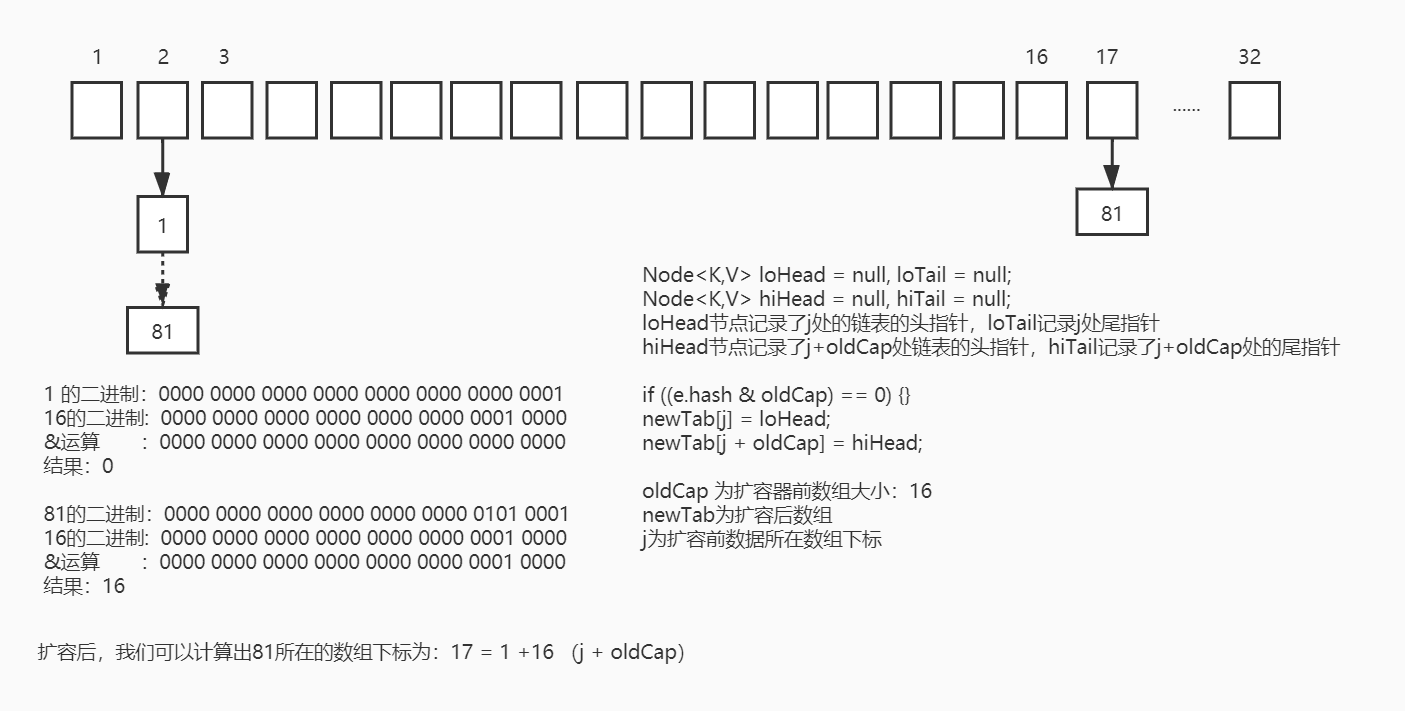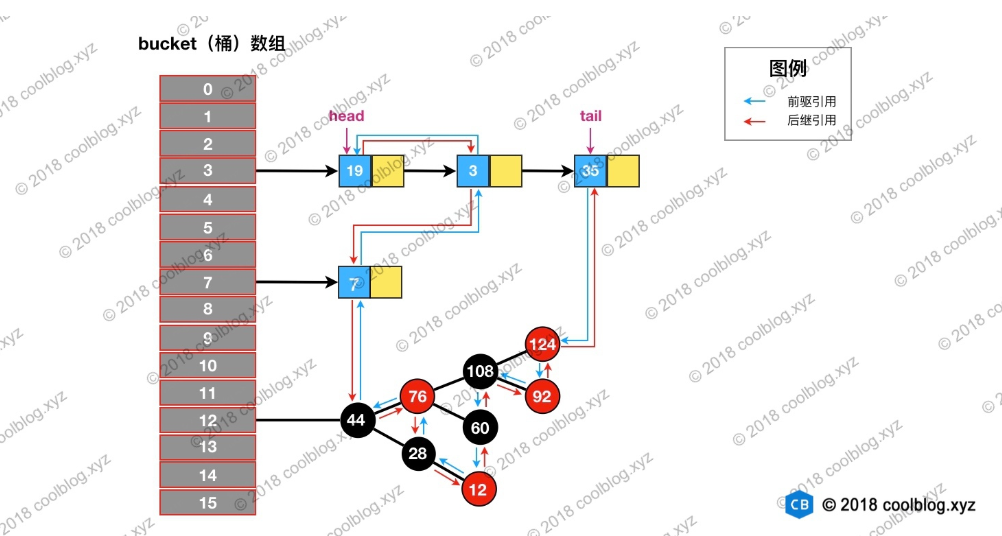说明
这里文章大多为复习内容,内容精简干练,为原有基础知识回顾
ArrayList,LinkedList
使用到的工具类
System.arraycopy(srcElements, srcIndex, targetElement, tarIndex, srcLength);
Arrays.copyOf(数组,型数组长度);
位运算复习
x>>1 等价于: x / 2 (2的1次方)
x<<1 等价于: x * 2 (2的1次方)
^ 异或 1 ^ 0 = 1, 1 ^ 1 = 0, 0 ^ 0 = 0
& 与 1 & 1 = 1 其余都为0 所以&结果都趋向0
| 或 0 | 0 为0 其余都为1 所以|结果都趋向1
HashMap
logn、 lgn 数学知识学习
一般的,如果a^x = N
那么数x叫做以a为底N的对数,x = logaN, 其中a叫做底数
lgn是以10位底n的对数
时间复杂度:Ο(1)<Ο(log2n)<Ο(n)<Ο(nlog2n)<Ο(n2)<Ο(n3)<O(n!)
JDK8中hash算法
hash算法:return (key == null) ? 0 : (h = key.hashCode()) ^ (h >>> 16);
h是key的hashcode, 结果为a
h右移16位 也就是key的高16位移动到低16位,结果为b
a ^ b 相当于:key的hashcode高16位和低16位异或运算,能够使hashcode低16位更加散乱, 真正计算槽位的算法只有低16位会参与运算
hashMap key值寻找数组位置的方法:(n - 1) & hash n是数组长度
hashMap默认长度为16,这个算法为 15 & hash
几个问题:
为什么用右移16位
真正计算数组位置的用的是低16位,所以右移可以将高16位起到作用,使得hash更加散乱
为什么用^计算高16位和低16位
&结果趋向0 |结果趋向1 只有^后的结果会更加散乱
& 计算只有两个都为1 才是1,所以结果趋向0
| 计算还有两个都为0才是0, 所以结果趋向1
为什么槽位必须是2^n
- 例如长度是17, 17 - 1 = 16,二进制是 00010000 最后计算&操作时,结果不是1就是16,而16 - 1 = 15, 二进制是00001111, 低4位1111计算会有更多结果
- 方便位运算:key % (2^n) 等价于 key & (2^n - 1)
put的详细解读
1final V putVal(int hash, K key, V value, boolean onlyIfAbsent,
2 boolean evict) {
3 Node<K,V>[] tab; Node<K,V> p; int n, i;
4 // 如果table没有初始化,那么则先使用resize,newCap = DEFAULT_INITIAL_CAPACITY; 这里初始化数组大小的意思 默认为1<<4=16
5 if ((tab = table) == null || (n = tab.length) == 0)
6 n = (tab = resize()).length;
7 // tab[i=(n-1)&hash] 意思是 计算数组的槽位,n-1&hash 等价于 hash%n
8 // p就是这个通过hash计算的槽位的Node信息
9 if ((p = tab[i = (n - 1) & hash]) == null)
10 tab[i] = newNode(hash, key, value, null);
11 else {
12 Node<K,V> e; K k;
13 // p.hash == hash 说明通过hash计算的槽位已经有值了
14 // (k = p.key) == key 说明传入的key值和当前槽位的值地址相同
15 // key.equals(k) 说明传入的key值和当前槽位的值相同
16 // 如果hash值和key都相等 那么则将传入的value替换成当前槽位的值
17 if (p.hash == hash &&
18 ((k = p.key) == key || (key != null && key.equals(k))))
19 e = p;
20 else if (p instanceof TreeNode)
21 // 如果是树结构
22 e = ((TreeNode<K,V>)p).putTreeVal(this, tab, hash, key, value);
23 else {
24 // 此时说明hash冲突,且链表还没有转化成树
25 for (int binCount = 0; ; ++binCount) {
26 // 判断当前槽位的next是否为空
27 if ((e = p.next) == null) {
28 // 如果为空,则新建一个Node,p.Next = newNode
29 p.next = newNode(hash, key, value, null);
30 // 如果当前链表的长度,大于等于TREEIFY_THRESHOLD - 1 = 7 转化为红黑树
31 // bincount 从0开始的, 所以当bincount为7时,链表长度为8(算上数组槽位开始的那个节点,总长度为9)
32 if (binCount >= TREEIFY_THRESHOLD - 1) // -1 for 1st
33 treeifyBin(tab, hash);
34 break;
35 }
36 // 和上面判断一致,判断hash和e=p.next的key值是否一致
37 // 如果一致则直接退出,此时e=p.next 下面判断e!= null,则e.value=value替换
38 if (e.hash == hash &&
39 ((k = e.key) == key || (key != null && key.equals(k))))
40 break;
41 // p = e = p.next 然后继续for循环
42 p = e;
43 }
44 }
45 if (e != null) { // existing mapping for key
46 V oldValue = e.value;
47 if (!onlyIfAbsent || oldValue == null)
48 // 将value值覆盖当前槽位的值
49 e.value = value;
50 afterNodeAccess(e);
51 return oldValue;
52 }
53 }
54 ++modCount;
55 // 判断是否需要扩容,size 是hashMap中key-value键值对的数量
56 // threshold = 数组长度(模拟了16) * 负载因子(默认0.75) = 12
57 if (++size > threshold)
58 resize();
59 afterNodeInsertion(evict);
60 return null;
61}
hashmap扩容原理
扩容之桶计算规则
n = 16:
n-1 0000 0000 0000 0000 0000 0000 0001 1111
hash1 1111 1111 1111 1111 0000 1111 0000 0101
&结果 0000 0000 0000 0000 0000 0000 0000 0101 = 5(index = 5的位置)
扩容后n = 32:
n-1 0000 0000 0000 0000 0000 0000 0001 1111
hash2 1111 1111 1111 1111 0000 1111 0001 0101
&结果 0000 0000 0000 0000 0000 0000 0001 0101 = 21(index = 21的位置)
JDK 1.8,扩容一定是2的倍数,从16到32到64到128
就可以保证说,每次扩容之后,你的每个hash值要么是停留在原来的那个index的地方,要么是变成了原来的index(5) + oldCap(16) = 21
因此,我们在扩充HashMap的时候,不需要像JDK1.7的实现那样重新计算hash,只需要看看原来的hash值新增的那个bit是1还是0就好了,是0的话索引没变,是1的话索引变成“原索引+oldCap”。
扩容之桶计算规则图解
 01_JDK1.8 HashMap resize原理.jpg
01_JDK1.8 HashMap resize原理.jpg
扩容核心算法:
1final Node<K,V>[] resize() {
2 // 核心源码,省略了其他代码
3 // 遍历就数组元素
4 for (int j = 0; j < oldCap; ++j) {
5 Node<K,V> e;
6 // e等于当前j位置头结点元素
7 if ((e = oldTab[j]) != null) {
8 // 已经赋值给e了,这里可以直接设置为null,方便gc
9 oldTab[j] = null;
10 // 如果该处next元素为null,说明没有链表结构,直接做类似rehash操作
11 if (e.next == null)
12 newTab[e.hash & (newCap - 1)] = e;
13 else if (e instanceof TreeNode)
14 // 红黑树特殊处理
15 ((TreeNode<K,V>)e).split(this, newTab, j, oldCap);
16 else { // preserve order
17 // 扩容后的节点不在j位置就在j+oldCap(原始数组大小)位置
18 // loHead为j处位置节点低位node,loTail为j处节点最末端node
19 // hiHead为j+oldCap处位置节点低位node,hiTail为j+oldCap处节点最末端node
20 Node<K,V> loHead = null, loTail = null;
21 Node<K,V> hiHead = null, hiTail = null;
22 Node<K,V> next;
23 do {
24 next = e.next;
25 // 如果为0,说明扩容后的元素还在j这个节点位置
26 // 如果不为0,说明扩容后的元素会在j + oldCap节点位置
27 if ((e.hash & oldCap) == 0) {
28 // 如果j处尾节点为null,说明第一次设置。则设置e为头结点
29 if (loTail == null)
30 loHead = e;
31 else
32 // 设置头结点的next为e
33 loTail.next = e;
34 // e设置为尾结点,这就是尾插法
35 loTail = e;
36 }
37 else {
38 // 这个else分支就说明扩容后这些节点会散落到j+oldCap数组的桶上
39 // 同上,如果j+oldCap的尾节点为空 说明第一次设置,设置头结点为e
40 if (hiTail == null)
41 hiHead = e;
42 else
43 hiTail.next = e;
44 hiTail = e;
45 }
46 // 这里while循环是将j对应的桶上面所有的链表或者红黑树的Node全都rehash完
47 } while ((e = next) != null);
48 // 这里已经设置好 一个完整的链表结构了,这里是设置j和j+oldCap桶位置数据
49 if (loTail != null) {
50 loTail.next = null;
51 newTab[j] = loHead;
52 }
53 if (hiTail != null) {
54 hiTail.next = null;
55 newTab[j + oldCap] = hiHead;
56 }
57 }
58 }
59 }
60 return newTab;
61}
hashmap jdk1.8相对于1.7 优化了什么
- 数据结构改变
数组+链表 改为:数组+链表+红黑树 - hash算法改变
1.8中hash算法改为: (h = key.hashCode) ^ (h>>>16) 高低16位混合运算 - 扩容方式改变
头插法变成尾插法,并发情况下不会形成死锁
参考文章:
- 品HashMap(java8): https://juejin.im/post/5dec684e6fb9a016227786c0
- HashMap中的hash算法中的几个疑问:https://www.cnblogs.com/zxporz/p/11204233.html
- Java源码分析:HashMap 1.8 相对于1.7 到底更新了什么?:https://www.jianshu.com/p/8324a34577a0
LinkedHashMap
数据结构
LinkedHashMap 继承自 HashMap,在 HashMap 基础上,通过维护一条双向链表,解决了 HashMap 不能随时保持遍历顺序和插入顺序一致的问题。除此之外,LinkedHashMap 对访问顺序也提供了相关支持。在一些场景下,该特性很有用,比如缓存。
数据结构如图:(原图地址:http://www.tianxiaobo.com/2018/01/24/LinkedHashMap-源码详细分析(JDK1-8)/)
 image.png
image.png
插入数据
1// HashMap 中实现
2Node<K,V> newNode(int hash, K key, V value, Node<K,V> next) {
3 return new Node<>(hash, key, value, next);
4}
5
6// LinkedHashMap 中覆写
7Node<K,V> newNode(int hash, K key, V value, Node<K,V> e) {
8 LinkedHashMap.Entry<K,V> p =
9 new LinkedHashMap.Entry<K,V>(hash, key, value, e);
10 // 将 Entry 接在双向链表的尾部
11 linkNodeLast(p);
12 return p;
13}
14
15// LinkedHashMap 中实现
16private void linkNodeLast(LinkedHashMap.Entry<K,V> p) {
17 LinkedHashMap.Entry<K,V> last = tail;
18 tail = p;
19 // last 为 null,表明链表还未建立
20 if (last == null)
21 head = p;
22 else {
23 // 将新节点 p 接在链表尾部
24 p.before = last;
25 last.after = p;
26 }
27}
LinkedHashMap维护访问顺序
1// 如果accessOrder为true
2// 调用get/getOrDefault/replace方法 会将这些方法访问的节点移动到链表的尾部
3void afterNodeAccess(Node<K,V> p) { }
4// putValue的时候对调用
5void afterNodeInsertion(boolean evict) { }
6// remove时候调用
7void afterNodeRemoval(Node<K,V> p) { }
通过回调的方式,让 LinkedHashMap 有机会做一些后置操作。上述三个方法的具体实现在 LinkedHashMap中。
1// LinkedHashMap 中覆写
2public V get(Object key) {
3 Node<K,V> e;
4 if ((e = getNode(hash(key), key)) == null)
5 return null;
6 // 如果 accessOrder 为 true,则调用 afterNodeAccess 将被访问节点移动到链表最后
7 if (accessOrder)
8 afterNodeAccess(e);
9 return e.value;
10}
11
12// LinkedHashMap 中覆写
13void afterNodeAccess(Node<K,V> e) { // move node to last
14 LinkedHashMap.Entry<K,V> last;
15 if (accessOrder && (last = tail) != e) {
16 LinkedHashMap.Entry<K,V> p =
17 (LinkedHashMap.Entry<K,V>)e, b = p.before, a = p.after;
18 p.after = null;
19 // 如果 b 为 null,表明 p 为头节点
20 if (b == null)
21 // 将p的后置节点设置为head节点
22 head = a;
23 else
24 // 如果b不为空,说明p前置存在节点
25 // 那么将p的后置节点设置为b的后置节点
26 b.after = a;
27
28 // 判断p的后置节点,如果不为空
29 if (a != null)
30 设置a的前置节点为b
31 a.before = b;
32
33 // 如果p的后置节点为空, 这说明p为尾节点
34 // 这种情况会将p的前置节点设置为尾节点
35 else
36 last = b;
37
38 // 如果last为空,这说明链表没有元素,所以head = p
39 if (last == null)
40 head = p;
41 else {
42 // 将 p 接在链表的最后
43 p.before = last;
44 last.after = p;
45 }
46 tail = p;
47 ++modCount;
48 }
49}
LinkedHashMap实现LRU算法
上面已经知道,如果accessOrder是true,那么get等操作都会将tail指正指向该元素
HashMap putValue的时候对调用:afterNodeInsertion(evict) -> removeEldestEntry()
我们需要复写removeEldestEntry() 方法指定移除策略,然后会移除first元素
代码实现可参考我的demo:https://github.com/barrywangmeng/java-learning/tree/master/java-learning/src/main/java/cn/barrywangmeng/cache/lru